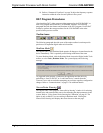
Digital Audio Processor with Room Control Crestron C2N-DAP8RC
30 • Digital Audio Processor with Room Control: C2N-DAP8RC Operations Guide - DOC. 8187A
The Mute button on the lower right of all screens is intended as a “panic” button to
prevent damage to speakers in the event of sudden large increases in sound level,
which can occur when switching from one sound source to another. Pressing this
button again does not turn mute off. Turn mute off, after the problem is resolved, as
stated above.
Using Source/Noise Steering for Calibration
Calibrating a room is a critical part of setting up a home theater. Without proper
calibration, the impact of a movie or musical soundtrack will lack what the sound
engineer had originally intended.
The Source/Noise Steering feature gives you three options to choose from to suit
your calibration needs. The definitions below give you the function of each type of
noise and its intended use for system calibration. The Source/Noise Steering feature
should be used with an SPL Meter and/or a Real Time Analyzer (RTA) for the best
possible calibration of the room.
Pink Noise:
Pink noise is sound that is comprised of a random signal, with all audio frequencies
present, over time, and at various signal levels. It provides equal energy per octave to
provide a flat response over all frequencies. (Refer to Graph 1 after the next
paragraph for visual reference.)
The main function of pink noise is to calibrate a speaker’s interaction within its
given room. The reason that pink noise is used over other generated noises such as
white noise is because of its equal power to all octaves. This makes it easier to
calibrate for a flat plot on a real time analyzer, since the level will be uniform across
every octave. Pink noise is provided by DAT software or you can use an external
source such as a DVD or CD. This would be used with the Room Calibration, Output
Settings, Graphic EQ and Parametric EQ tabs.
Graph 1:


















